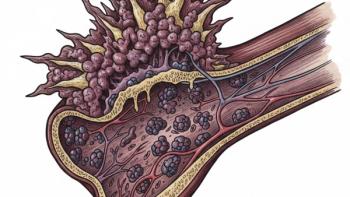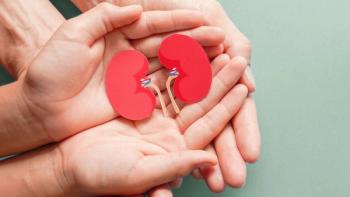
Research Unravels New Ways to Treat HER2-Positive Breast Cancer
New therapies and combinations make progress in HER2-positive breast cancer.
When Debra Tincher received a diagnosis of stage 2 breast cancer in 1997, testing for HER2-positive breast cancer wasn’t standard. She went through treatment and was cancer-free for more than 10 years, teaching kindergarten in Hamilton, Ohio.
In 2009, Tincher learned she had a recurrence—this time her hormone-positive, HER2-positive breast cancer was metastatic. She went the traditional treatment route, but when the cancer progressed, she knew it was time to pursue other options.
The clinical trial her physician offered wasn’t a hard sell, even with it being a phase 1 study. Because Tincher had severe side effects with the first drug on the study, her doctor offered to move her on to the next one in the clinical trial, an investigational HER2-targeted agent called T-DM1.
As her doctor drew a diagram on the whiteboard in the examination room, Tincher listened to an explanation of how the drug worked. Her doctor explained that T-DM1 was a new type of drug that fused a potent chemotherapy drug to Herceptin (trastuzumab), an antibody approved more than a decade before that targets the HER2 receptor on a cancer cell.
“The only question was if I wanted to remain in the trial and try T-DM1,” she says. “Hearing all the positive feedback, there was no doubt in my mind.”
Tincher had been following the story of T-DM1 through early-phase clinical trials—the Food and Drug Administration’s rejection of the drug’s application for accelerated approval in 2010 and the positive phase 3 study that was the top headline from the annual meeting of the American Society of Clinical Oncology (ASCO) this summer.
“Some people are very hesitant to go on a clinical trial. They see it as a last resort option, and that’s not necessarily true,” Tincher says. “I’m very happy to have found this one with my doctor.”
As a Metastatic Breast Cancer Network board member, Tincher is working on the organization’s national conference set for Oct. 13 in Chicago where she hopes to learn about more advancements in breast cancer, including news on HER2-positive cancers.
About a fifth of all breast cancers are considered HER2-positive, which means they contain an abundance of human epidermal growth factor receptor 2, or HER2, on the cell surface. These cancers tend to be more aggressive and were considered more fatal than other types of breast cancer until HER2-targeted agents, such as Herceptin, entered the scene.
Nearly 15 years after Herceptin was approved for metastatic HER2-positive breast cancer, there are now several treatments that zero in on the HER2 pathway and the HER family. There are four proteins that make up the HER receptor family: HER1 (more commonly known as EGFR or epidermal growth factor receptor), HER2, HER3 and HER4. While researchers developed Herceptin to block the HER2 receptor on the outside of the cell, they have since been able to develop other therapies that can block HER activity in other ways.
[Chart: The HER2 Family]
Patients will have their tumor tested for HER2 overexpression at initial diagnosis and following a recurrence, because HER2 status—as well as hormone receptor status—can change. Depending on how strongly the cancer expresses HER2 proteins will determine whether the patient would benefit from HER2-targeted therapy.
[Read how testing for HER2 overexpression in breast cancer works]
Patients with HER2-positive breast cancer have several treatment options, including Herceptin and Tykerb (lapatinib), which are often combined with chemotherapy drugs, such as Xeloda (capecitabine), paclitaxel, docetaxel, vinorelbine and others. These drugs are used in combinations and with other investigational agents, as discussed below.
The most recent therapy to join the ranks of HER2-targeted agents is Perjeta (pertuzumab), which was approved by the FDA in June for metastatic disease or breast cancer that has recurred locally and can't be surgically removed. Perjeta works by preventing the HER2 receptor from pairing with other HER receptors, blocking cancer cell growth. It’s also believed the drug can help the body’s immune system to identify and kill cancer cells.
Perjeta is used in combination with Herceptin and docetaxel. Perjeta and Herceptin are thought to complement one another as they both target HER2 but in different areas, a strategy that appears to work well in other HER2 regimens.
Perjeta was granted a priority review by the FDA after results of the phase 3 CLEOPATRA trial were announced at a large breast cancer meeting in late 2011. More than 800 previously untreated patients with metastatic HER2-positive breast cancer received Herceptin and docetaxel either with Perjeta or a placebo. Patients in the Perjeta group had a median progression-free survival of 18.5 months compared with 12.4 months in the control arm. Side effects included neutropenia, febrile neutropenia and diarrhea. Perjeta is now being studied in early-stage HER2-positive breast cancer.
Tykerb (lapatinib), approved in 2007, is unique in that it targets the HER2 pathway inside the cell instead of blocking the receptor on the cell surface, as well as EGFR. The drug also has the ability to pass through the blood-brain barrier, a barrier that blocks systemic therapy in the circulating blood from reaching the brain. The small molecule’s makeup is believed to allow it to treat metastatic breast cancer that has spread to the brain.
It is approved in combination with Xeloda for patients whose cancer has progressed on Herceptin and other therapies, and with an aromatase inhibitor in patients who have a type of metastatic breast cancer that is HER2-positive and estrogen receptor-positive. Aromatase inhibitors, such as letrozole, lower the production of estrogen, which is used in tumor growth.
Although data looking at Tykerb in early-stage HER2-positive breast cancer were disappointing, researchers are now examining whether combining Tykerb with Herceptin in advanced disease will result in a synergistic effect.
Illustration: Herceptin and Tykerb Target HER2 Differently
A study published in The Lancet earlier this year showed that women with early-stage breast cancer who received both drugs with paclitaxel fared better than women on either drug alone with paclitaxel. Patients in the phase 3 study called NeoALTTO were given one of the three regimens before surgery. The strategy, called neoadjuvant treatment, aims to shrink the tumor before surgery and in the research setting, can estimate the effectiveness of new drugs and combinations. After surgery, patients received chemotherapy and then continued on their regimen for 52 weeks. The patient group that received the combination had a complete response of 51 percent compared with about 25 and 30 percent for the Tykerb and Herceptin groups, respectively. A much larger trial testing the drugs after surgery, simply called the ALTTO study, is expecting results in 2013.
In a separate phase 3 study, the combination extended overall survival in patients with HER2-positive metastatic breast cancer who had already received numerous therapies. The results of trial EGF104900, which were published in a June 2011 issue of Journal of Clinical Oncology, showed median overall survival at 14 months and progression-free survival at 11.1 weeks compared with Tykerb alone at 9.5 months and 8.1 weeks, respectively. Factors such as disease site, overall health, number of metastatic lesions and length of time from diagnosis impacted survival time.
Unfortunately, combining therapies typically increases side effects, as well as cost. Severe side effects were more common in the combination group in the EGF104900 study and included cardiac toxicity. Other side effects reported were diarrhea, nausea, rash, fatigue and vomiting.
Although the combination appears promising, the company that produces Tykerb withdrew its application to the FDA for expanding Tykerb’s use to await more data. A spokesperson for GSK, Tykerb’s maker, said in an email to CURE, “… additional data was needed to completely address the questions the FDA determined would be needed to complete the review. We have ongoing trials taking place right now looking at the combination for Tykerb and trastuzumab [Herceptin].” A timeline for the clinical trial data and re-submission is unknown at this time. In the meantime, studies testing the two drugs in combination and in sequence are ongoing.
At ASCO’s annual meeting in June, results of a study testing T-DM1 indicated it did better than the standard second-line treatment of Tykerb and Xeloda and produced fewer side effects.
As Tincher learned, T-DM1 is an antibody-drug conjugate. The drug is created by fusing the Herceptin antibody to a strong chemotherapy drug called emtansine. The chemotherapy’s potency is at least 100 times more powerful than paclitaxel, and administration without severe side effects has limited its use until now. Linking the drug to Herceptin, which delivers it directly to the cancer cell like a “Trojan horse,” reduces those side effects. The drug appears to work even in patients whose cancers have progressed on Herceptin, like Tincher’s.
Tincher says it was hard to hear that the FDA had decided not to grant accelerated approval to T-DM1. “I am frustrated and upset that the FDA is going slowly, while there are many women that could benefit from the drug right now.”
Before participating in the trial, she had read several personal accounts about the investigational drug on online message boards, and many said they had seen success on it with few side effects.
“When I’m on this drug, I have a good quality of life. That means a lot to me,” says Tincher, who noted that she’s only experienced fatigue while on the trial.
However, the government agency usually only reserves accelerated approval for therapies that show early signs of effectiveness and fill an unmet need in the patient population. In T-DM1’s case, the agency explained that the patients in the study had not exhausted all treatment options before receiving T-DM1. Follow-up data from the large phase 3 trial EMILIA announced at ASCO may be enough to gain the agency’s full approval, which is expected late this year.
Patients in the study were given either an infusion of T-DM1 every three weeks or Xeloda and Tykerb. After two years, women on T-DM1 lived 9.6 months without their disease worsening compared with 6.4 months for women on Xeloda and Tykerb. Researchers say there appears to be a survival advantage with T-DM1, but they will need to wait for more data before they can say definitively. At the two-year follow-up, 65.4 percent of patients on T-DM1 were alive compared with 47.5 percent on the standard treatment.
Close to 18 more women out of a 100 were alive because they got one drug over the other, says Kimberly Blackwell, MD, who presented the data at the annual ASCO meeting in early June.
“We’ve never seen that absolute difference in overall survival in a drug that doesn’t induce life-altering toxicity. We haven’t even seen that amount of survival benefit in highly toxic treatments,” she said in an interview with CURE at the meeting.
Data from the EMILIA trial will be submitted to the FDA later this year for approval in metastatic, HER2-positive breast cancer. “This is a very different survival curve than some of the more controversial drugs that have been presented at the [FDA] agency in the past two years.”
Side effects reported in the T-DM1 study group included thrombocytopenia, a drop in platelets in the blood that can increase bleeding, although actual bleeding problems were rare. Side effects, such as vomiting, diarrhea and hand-foot syndrome, were less common in the T-DM1 arm. Additionally, Blackwell says there were no reports of symptomatic congestive heart failure, a rare but serious side effect seen with Herceptin.
“The caveat there is that patients received prior trastuzumab (Herceptin), so we make an assumption there that they had healthy hearts,” Blackwell says.
Additional clinical trials with T-DM1 are looking at pairing it with Perjeta, but the best way to use them together is still unknown.
“Another thing that needs to come into discussion is if I give you T-DM1, can I give you pertuzumab (Perjeta) later or vice versa? We don’t really have any information on that until the official availability of these drugs,” Blackwell says. “But… there are so many options now for HER2-positive breast cancer.”





